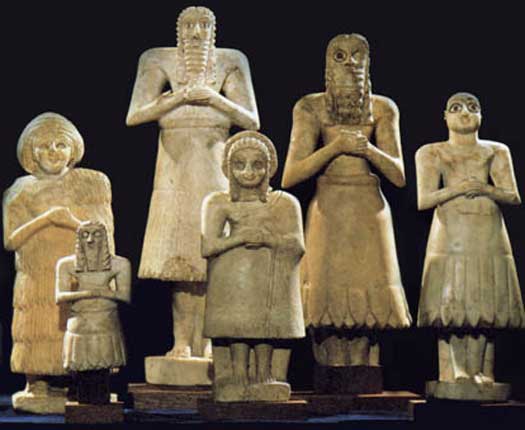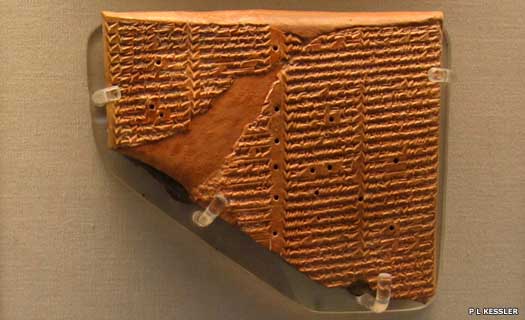
| CITY STATE OF ESHNUNNA The minor city of Eshnunna (modern Tell Asmar) was situated in the Diyala Valley to the north-east of Sumer itself, but it was still very much a part of Sumerian culture and civilisation. Occupied from circa 2900 BC, it was never a significant power during Sumerian times, but in the period of Ur's Third Dynasty it was a well-attested city and capital of one of Ur's provinces with the same name. As Ur headed towards collapse, the city (which is not mentioned in the king list) gained an independent dynasty of its own. Its kings, some of whom bore Elamite names, may even have been united with Assyria for a time, and were a threat to later Babylonian hegemony.
Although information on the kingdom is sparse, a historical framework for Amorite Eshnunna can be pieced together from building inscriptions, year dates, letters, and seal inscriptions both from Eshnunna and elsewhere. The history of the city of Nuzi is closely interrelated with that of the nearby towns of Eshnunna and Khafajah. There were apparently twenty-eight kings for Eshnunna between 2065 - 1762 BC although six are missing from this list.
fl c.2030 BC :
Ituria : Governor? under Ur.
Ituria, a city leader, builds a temple for his divine overlord, Shu-Sin of Ur. Soon afterwards a palace is attached to this.
fl c.2026 BC :
Shu-ilija / Ilshu-Ilia : Son. Claimed the independent kingship of the city.
c.2026 BC :
Eshnunna breaks away from the control of Ur during the second year of Ibbi-Sin's reign. Shu-ilija maintains good relationships with Ishbi-Erra of Isin as does his successor. However, the succeeding kings drop the title of king to use the lesser one of 'Únsi' (governor) or 'ishshakum' insisting that the kingship of the state belongs to the city's god, Tishpak.
Figurines from Eshnunna, probably from the period around 2000 BC fl c.2010 BC :
Nurahum / Nur-Akhum : Received help from Isin to win a battle against Subartu.
Kirikiri : Bore an Elamite name.
Bilalama : Bore an Elamite name.
Eshnunna appears to maintain close contacts with Elam, although it seems not to have been conquered by the Elamites.
Ishar-Ramashshu
fl to c.1940 BC :
Usurawassu / Usur-Awasu :
The city is sacked during the time of Usurawassu, possibly by Anum-muttabbil of Der, and may be temporarily subject to that city. Little is known about the subsequent nine rulers.
Abimadar : Not on all lists.
Azuzum
Urninmar / Ur-Ninmar / Ur-Ninkimara
Urningishzida / Ur-Ningizzidda
Ipiqadad I / Ibiq-Adad I
Abdi-Erah
Shiqlanum
fl bef c.1895 BC :
Sharrija / Sharria
Belakum / Belakim
Warassa
fl c.1870 BC :
Ibalpiel I : Reigned for at least ten years (from a seal impression).
Eshnunna seems to flourish again, perhaps due to the decline of Isin and Larsa from the middle of the century. Ibalpiel re-adopts the title of king, perhas in recognition of the fact that there is no longer a single 'kingship of Sumer and Akkad' to which to defer.
c.1862 - 1818 BC :
Ipiqadad II / Ibiq-Adad II : Son. Assumed divine status - practice copied by all successors.
Ipiqadad pursues an expansionist policy. The previously independent minor cities of Nerebtum (modern Ishcali), Shaduppum (Tell Harmal), and Dur-Rimush (location unknown) are all incorporated into the state.
fl c.1830 - 1815 BC :
Naramsin / Naram-Sin : Son. Also king of Assyria, probably by conquest.
Naramsin extends Eshnunna's territory considerably into northern Babylonia at a time when the small kingdom based at Babylon can do little more than defend its own walls, and apparently also temporarily conquers the Assyrians at Ashur, as well as the small state of Ekallatum.
Dannum-tahaz : Son? May have ruled briefly after Ibalpiel II.
c.1808 - 1780 BC :
Dadusha : Son of Ipiqadad II.
c.1780 BC :
The kingdom of Upper Mesopotamia turns on its recent ally and seizes Nerebtum and Shaduppum, although these and more are quickly taken back upon the death of Shamshi-Adad in 1766 BC.
c.1779 - 1765 BC :
Ibalpiel II / Ibal-pi-El II : Son or grandson. One of the major leaders of this period.
c.1776 BC :
The kingdom of Upper Mesopotamia is attacked simultaneously by Yamkhad and Eshnunna, leading to its disappearance and a general restoration of the old order.
c.1766 BC :
Eshnunnan troops take part in the siege of Razama by Atamrum of Andarig, but Ibalpiel hurries to assist Razama, collecting troops and a battering ram from his governor in Qattunan on the way. The Razamans manage to repel Atamrum before he arrives, so he returns home.
c.1764 - 1762 BC :
Silli-Sin
c.1764 BC :
Eshnunna had been forming ties with Mari in the face of Babylon's growing power, but as part of a coalition which attempts to invade Babylonia the city is defeated and crushed by Hammurabi.
c.1762
BC : The Babylonian empire captures the only remaining political power to oppose them when they take Eshnunna, inheriting well-established trade routes and economic stability, and ending 250 years of Eshnunna's independence.
c.1762 BC :
The Babylonian empire captures the only remaining political power to oppose them when they take Eshnunna, inheriting well-established trade routes and economic stability, and ending 250 years of Eshnunna's independence.
Ancient Mesopotamian names were always meaningful, and were therefore translatable into other languages, as with this tablet, which records a large number of exotic, non-Akkadian names in Akkadian c.1756 BC :
There is evidence that just four years after its supposed capture, the entire town is ravaged by a terrible flood. After that, the city only rarely appears in cuneiform textual sources, reflecting a probable decline and eventual disappearance.
Iqishi-Tishpak : Descendant of Naramsin? Vassal of Babylon?
? - c.1736? BC :
Anni : Killed in Babylon.
c.1741 - 1736 BC :
One of Eshnunna's last notable acts is to side with Rim-Sin II of Larsa in his revolt against the Babylonian empire. Anni is captured by the Babylonians and is strangled. The city is destroyed.
Source :
https://www.historyfiles.co.uk/ |

